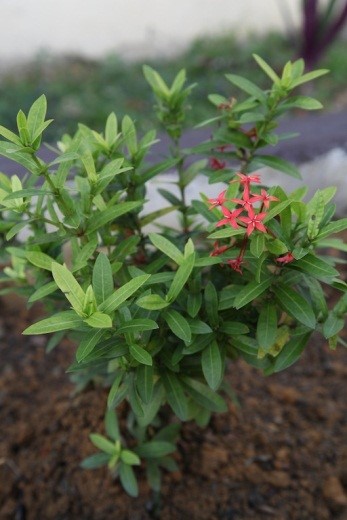Jejarum/siantan
| Jejarum/siantan | |
| Scientific Name | Pxora coccinea |
| Order | Gentianales |
| Family | Rubiaceae |
| Synonyms | Ixora coccinea L., Ixora grandiflora Bot., Ixora bandhuca Roxbg |
| Common Name |
Jungle geranium, flame of the woods, jungle flame,burning love, red ixora |
 |
{slider=Description}
The flowering shrub with height capable reaching up 3m. The dark green leaves are glossy, leathery, oblong leaves in 10cm long with entire margins and carried in opposite pairs or whorled on the stems. Its inflorescences are in small tubular, scarlet flowers in dense rounded clusters 5-13cm. The flower has tubular, 4 petaled, bright red flowers bloom in coyrmbose cymes (each to 5 wide). Primary bloom in summer, but sporadic bloom occurs throughout the year. It has woody stems are clad with opposite, leathery, elliptic to oblong, glossy, dark green leaves.The fruits are fleshy, globose berries that ripen to a dark red or purplish black (Liogier, 1997).
{/slider}
{slider=Geographical & Distribution}
Southern Indian, Sri Lanka and growing in the tropical and subtropical climates of the world.
{/slider}
{slider=Traditional Uses}
In India, the infusions of the leaves and juice from roots are used to treat dysentery, ulcers and gonorrhea (Parrotta, 2001).
{/slider}
{slider=Chemical Constituents}
Phytochemical research indicate that the plant contains the phytochemicals lupeol, ursolic acid, oleanolic acid, sitosterol, rutin, lecocyanadin, anthocyanins, proanthocyanidins, and glycosides of kaempferol and quercetin (Manjeshwar et. al., 2012). Flowers contain rutin, lecocyanadin glycoside, cyanadin rutinoside and delphinidin monoglycoside. Form a methanol extract of the flowers, 13 chemicals, were identified, including ursolic acid, which has known antitumor and antiviral activity (Monteath et al., 2001). The major compounds are lupe ursolic acid, oleanolic acid, stearic acid, oleic acid, linoleic acids and sitosterol (Manjeshwar et. al., 2012). Leaves :contain ixoratant, epicatechin, procyanidin, cinnamtannin and the flavon-3-ol rhmnosides the kaempferol-7-α-l-rhamnoside, kampferol-3-O-α-l-rhamnoside quercetin-3-O-α-l-rhamnopyranoside and kaempferol-3,7-O-α-l-dirhamnoside (Manjeshwar et. al., 2012). Root bark contains octadecadienoic acid while the root has been shown to possess methyl esters of palmitate stearic, oleic and linoleic acids.
{/slider}
{slider=Pharmacology}
Pharmacological studies suggest that the plant possesses antioxidative, antibacterial, gastroprotective, hepatoprotective, antidiarrhoeal, antinociceptive, antimutagenic, antineoplastic and chemopreventive effects, thus lending scientific support to the plant’s ethnomedicinal uses (Manjeshwar et. al., 2012). The flowers of I.coccinea L. are extensively used in Ayuvedic medicine. The antitumor properties by protective effect of the active fraction of I.coccinea flowers against cisplantin induced toxicity in Swiss albino male mice was reported. (Latha and Panikkar, 1998).
Protection against hepatic toxicity The active fraction in flowers of Ixora coccinea was identified is triterpenoid and ursolic acid. The compounds showed chemoprotective effects on cyclophosphamide induced toxicity by increasing the life span of treated male Swiss albino mice and preventing body weight loss. The haematological effects of the compounds are maintaining near normal leucocyte and haemoglobin levels compared with cyclophosphamide treated controls. However in biochemical studies indicated the decreased of serum glutamate pyruvate transaminase (SGPT) and serum alkaline phosphatase (SAKP) levels in the Ixora coccinea treated groups indicated protection against hepatic toxicity (P.G.Latha et. al., 1999).
Chemoprotective effects The active fraction from Ixora coccinea flowers prevented a decrease in body weight, haemoglobin levels and leucocyte counts of Swiss albino male mice treated with cisplastin. Cisplatin is an effective used in chemotherapeutic drug. It also significantly prolonged the life span of cisplastin treated mice and maintained their blood urea nitrogen levels in the near normal range, indicating chemoprotective effects (P.G.Latha et. al., 2001).
{/slider}
{slider=References}
- Lioger, H. A. 1997. Descriptive flora of Puerto Rico and adjacent islands. Vol. 5. Editotial de la Universidad de Puerto Rico, San Juan, PR. 436p.
- Kumer, T.K., C.E. Rajini, V.K. Sasidharan, and T. Krishna Kumar. 1997. Antibacterial and antifungal activity of secondary metabolites from some medicinal and other common plant species. Journal of Life Science 2:14-19.
- Latha. P.G. and K.R. Panikkar. 2000 . Inhibition of chemical carcinogenesis in mice by Ixora coccinea flowers. Pharmaceutical Biology 38(2): 152-156.
- Monteath, S.A.F.A., V.V. Veiga, A.C. Pinto, A. Echevaria, and M.A.M. Maciel. 2001. Constituentes quimicos das flores de Ixora coccinea. Universidade Federal Rural do Rio de Janeiro. http://www.sbq.org.br/ranteriores/23/resumos/1147.3 p.
- Parrotta, J.A. 2001. Healing plants of peninsular India, CAB International, Wallingford, UK and New York. 944p.
- Latha. P.G. and K.R. Panikkar. 1999 . Modulatory effects of Ixora coccinea flower on cyclophosphamide-induced toxicity in mice. Phytotherapy Research 13: 517-520.
- Latha. P.G. and K.R. Panikkar. 2001 . Chemoprotective effect of Ixora coccinea L. Flowers on cisplatin induced toxicity in mice. Phytotherapy Research 15:364-366.
Manuscript prepared by Zaleha Md Toha
{/slider}
- Last updated on .
- Hits: 2920
